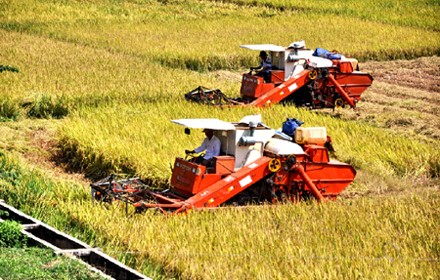(VOVworld) – The Prime Minister has approved the third phase of its socio-economic development program for especially disadvantaged communes of ethnic minority groups in Vietnam’s mountain regions, which is called Program 135. The 3rd phase targets helping people escape poverty and solving problems related to implementing poverty reduction policies at the local level.

Program 135 focuses on mechanized harvest (photo: chuongtrinh135.vn) |
After 16 years of implementing Program 135, Vietnam has been recognized as one of the most successful countries in the world in poverty reduction and economic development. Program 135 has fundamentally changed the face of extremely poor areas. The lives of ethnic minority people have improved and the poverty rate has fallen at a yearly average of 3.6%. Despite the Government and people’s effort, the development gap between mountainous, ethnic minority regions and other regions is wide. A report by the Government’s Committee for Ethnic Minority Affairs indicates that 149 of Vietnam’s 9,000 communes don’t have automobile road access to the centre of the commune; 67.2% of hamlets have no paved roads, 202 communes have no access to electricity at the centre; 8,100 hamlets have no electricity; and 32.2% of households don’t have access to clean water. The report says 218,000 communal officials need to improve their knowledge, and 120,000 poor households in border hamlets can’t feed themselves. The third phase of Program 135 targets sustainable poverty reduction. Hoang Van Doan is Deputy Director of the Lang Son provincial Department of Agriculture and Rural Development. "The segment to support production is of great importance in helping ethnic minority people escape poverty. Poor families are unable to buy new varieties and apply scientific and technological knowledge to improve their incomes so the Government’s subsidy of plants and animals is important."
Dinh Cong Nen, Chairman of the Chieng Sai communal People’s Committee in Son La province, says that poor infrastructure is a common issue in mountainous, ethnic minority regions. It causes the high rate of falling back into poverty because people can’t improve their production or connect with agricultural outlets. Dinh Cong Nen says: "It’s difficult to travel on these roads. They need better roads for traveling and transporting farm produce. We are focusing on improving rural roads."
Dang Kim Son, Director of the Institute of Policy and Strategy for Agriculture and Rural Development of the Ministry of Agriculture and Rural Development, says the third phase of Program 135 will concentrate on building infrastructure and developing production to create breakthroughs in mobilizing investment resources. The yearly estimated investment is 50,000 USD for each commune, which could rise to 100,000 or 125,000 USD by 2015. Diverse investment resources are needed, with the State playing the role of stimulator to attract social investment in agriculture, farmers, and rural areas in mountain and remote areas. Mr. Son elaborates: "In order to draw investment to the countryside, it’s important to study what kind of infrastructure the enterprises need and facilities for agricultural production. When we have identified the portfolio, we have to resolutely invest. The government may be in charge of one part, businesses do four parts, and the farmers can donate land."
Giang Seo Phu, Minister and Chairman of the Government Committee for Ethnic Minority Affairs, says one of the new features of the third phase is increasing the policy implementation time from 5 to 10 years so localities have enough time to implement, review, and evaluate their progress. Minister Phu says: "The third phase will continue to fulfill pending issues in the previous phases. A new task is to train human resources. If we want to have good results, we’ll need more capable managers."ethn
The goal to reduce the percentage of poor households to 5% by 2015 is a big challenge, which will require fundamental changes in policy and investment resources. The third phase of Program 135 will play a crucial role.
Minh Long